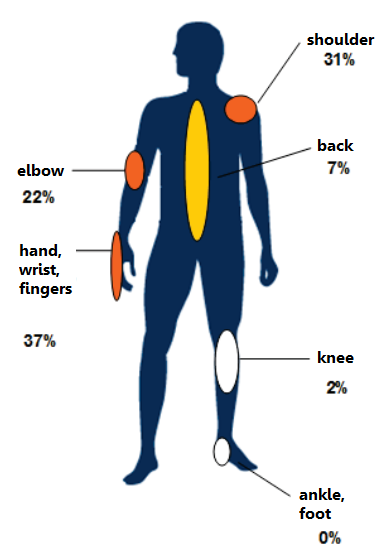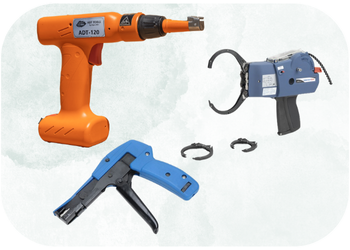MSDs, the leading cause of disability in the manufacturing industry
What are Musculoskeletal disorders?
Musculoskeletal disorders (MSDs) are disorders that affect muscles, tendons, nerves and joints. They are often caused by repetitive movements, poor posture, high workloads, or unfavourable ergonomic working conditions.
They affect employees by causing chronic pain, loss of strength and mobility, and can have a negative impact on the quality of life of sufferers. These consequences also cause financial losses due to medical costs or reduced wages. But they also affect the company, both in its productivity and financially.
MSDs in figures
Figure for all MSDs
As the most common cause of pain and disability among workers in many countries, they are responsible for about 40% of all occupational diseases worldwide and affect a wide range of occupations.
We can see the example of France from the statistics of the Social Security, the National Health Insurance Fund (CNAM) and Santé Publique France.
Of the total number of recognised cases of occupational diseases, which were around 50,000 in 2021, MSDs accounted for 86%. However, this figure does not take into account unrecognised MSDs. It is estimated, however, that there is between 53 and 73% under-reporting.
They can affect all occupational sectors, but some are more at risk than others because of the tasks and physical activities they involve. Here are some of the sectors most affected by MSDs in France:
- Care activities
- Manufacturing industry
- The transport and logistics sector
- The construction sector
- The catering and hotel sector

The main locations of MSDs in France in 2017
Source : CNAM
Carpal tunnel syndrome

Carpal tunnel syndrome is one of the most frequent MSDs and the most often recognised as an occupational disease in France.
The cable ties tightening operation carried out on assembly lines is a good example to see the different impacts that carpal tunnel syndrome can have.
This operation is mainly carried out using manual tools, and therefore requires a great deal of force on the part of the operator to tighten and cut the ties repeatedly, which causes tension in the operator's hand and wrist.
According to the CNAM data for 2019, there were 11,618 new cases of carpal tunnel syndrome recognised as occupational diseases that year, which represents around 23.3% of all MSD cases. There are also more than 130,000 people operated on in France each year. The under-reporting rate for this disorder has nevertheless been estimated at 60%. The CNAM also provided details for certain occupational sectors that year:
- Care activities: 3,464 new cases of the syndrome, representing about 29.8% of all cases.
- Manufacturing industry: 2,133 new cases of the syndrome, representing about 18.4% of all cases.
- The construction sector: 1,040 new cases of the syndrome, representing about 8.9% of all cases.
- The trade, transport and accommodation and catering sector: 1,008 new cases of the syndrome, representing about 8.7% of all cases.
- Administrative and support service activities: 753 new cases of the syndrome, representing about 6.5% of all cases.
How much can it cost?
For the operator
The costs of MSDs can be difficult to estimate as they will depend on individual circumstances and many factors such as the country, the health system, the treatment needed, the length of time away from work and the level of health insurance cover.
However, they can be defined as direct and indirect costs. The former consists of medical costs, the latter include loss of income.
For the company
The cost of carpal tunnel syndrome to a company can also vary depending on many factors, such as the size of the company, the number of workers affected, the severity of the symptoms, the amount of time away from work needed to recover, and the costs associated with implementing preventive measures.
In general, the syndrome can result in direct costs, such as compensation payments to employees, or indirect costs, such as lost productivity. The average total cost can therefore vary from a few thousand to several tens of thousands of euros.
For public organisations
MSDs accounted for 86% of recognised occupational diseases in France in 2021, and their compensation approached 2 billion euros. It should also be noted that the real costs of MSDs may be even higher, as many cases of MSDs are not officially recognised as occupational diseases and are therefore not included in these figures.
It should also be noted that Social Security is financed by workers' and employers' social security contributions, as well as by taxes. Therefore, the cost of MSDs to Social Security may also have wider financial implications for society as a whole.
In conclusion?
Musculoskeletal disorders are the main occupational diseases, not to mention those that are not declared as such.
It is therefore recommended that a company implement an MSD prevention approach in order to reduce the risks of these disorders occurring, in particular by improving the ergonomics of workstations, by training employees in good practices, and by implementing appropriate work organisation and management measures.

What solutions concerning the assembly?
Having mentioned the tightening operation, there are solutions to alleviate these disorders.
ADT Tools offers a powered solution to avoid this. The electronics and motorisation provide the necessary force and thus avoid these problems, in addition to better quality and productivity.


 Healthier and happier workforce
Healthier and happier workforce
 Improved Quality and Process
Improved Quality and Process
